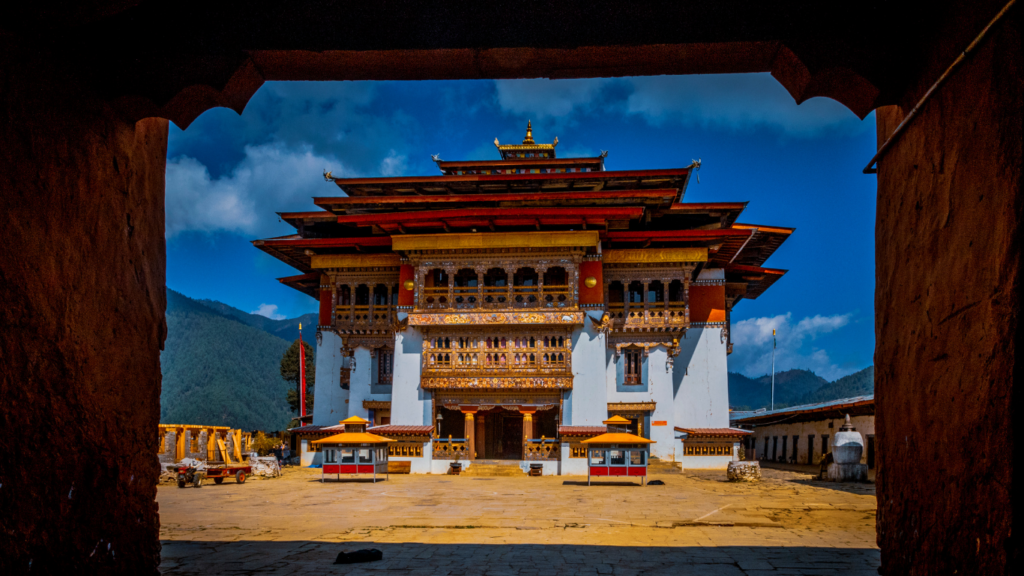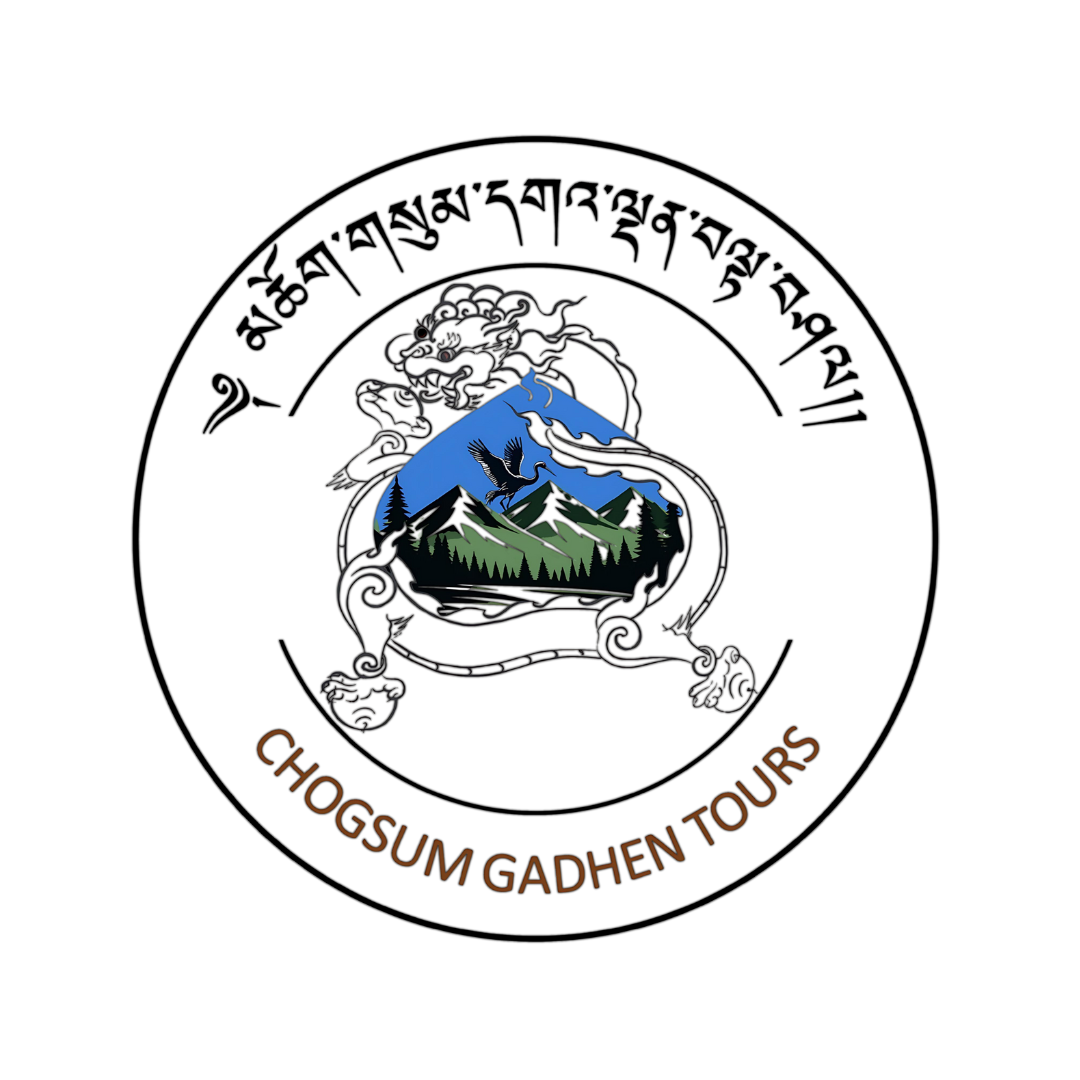Call Us:+975-17615031
Tashichho Dzong of Bhutan
Tashichho Dzong: The Heartbeat of Bhutan’s Governance and Spirituality
Nestled on the banks of the Wang Chhu River, Tashichho Dzong stands as a grand symbol of Bhutanese culture, governance, and spirituality. This impressive monastery-fortress is not only the seat of the Bhutanese government but also a vibrant center of religious activities, making it a cornerstone of Bhutan’s heritage.
A Historical Landmark
Tashichho Dzong, which translates to “Fortress of the Glorious Religion,” was originally built in 1641 by Zhabdrung Ngawang Namgyal, the unifier of Bhutan. Over the centuries, it has undergone several renovations and expansions, with the most significant reconstruction occurring in the 1960s under the third King, Jigme Dorji Wangchuck. This extensive restoration preserved the dzong’s historical essence while adapting it to modern needs.
The dzong’s location by the river and its extensive gardens add to its majestic presence, making it a serene yet imposing sight. The structure’s whitewashed walls, golden-tipped roofs, and intricate woodwork reflect the craftsmanship and artistic heritage of Bhutan.
Dual Role: Governance and Monastic Life
Tashichho Dzong serves a dual purpose, housing both the throne room and offices of the King of Bhutan as well as the central monastic body led by the Je Khenpo (Chief Abbot). This unique combination of political and religious functions underscores the deep intertwining of governance and spirituality in Bhutanese society.
During the summer months, the Je Khenpo and the monks move to Tashichho Dzong from their winter residence in Punakha Dzong, making it a hub of monastic activities. The dzong’s role as a religious center is highlighted during important festivals such as the annual Thimphu Tshechu, where the courtyards come alive with vibrant dances, rituals, and performances.
Architectural Marvel
Tashichho Dzong’s architecture is a blend of functionality and aesthetic beauty. The fortress is built in the traditional Bhutanese style, characterized by massive stone walls, intricate wooden windows, and elaborate frescoes depicting scenes from Buddhist mythology. The central utse (tower) rises prominently, symbolizing the dzong’s strength and endurance.
The dzong’s spacious courtyards and assembly halls are adorned with sacred statues and relics. Visitors can marvel at the artistry of the murals and carvings that grace the walls, each telling stories of Bhutan’s spiritual journey and historical milestones.
A Living Heritage
Despite its age, Tashichho Dzong remains a living, breathing entity, continuously adapting to the changing times while preserving its cultural essence. It stands as a testament to Bhutan’s ability to harmoniously blend tradition with modernity, making it a vital part of the nation’s identity.
Buddha Dordenma: The Radiant Sentinel of Thimphu Valley
Overlooking the sprawling Thimphu Valley, the Buddha Dordenma statue is a magnificent beacon of peace and prosperity. This colossal golden statue of Shakyamuni Buddha not only dominates the skyline but also embodies the spiritual aspirations of Bhutan.
A Monumental Vision
Buddha Dordenma, standing at a towering height of 54 meters, is one of the largest Buddha statues in the world. Commissioned to celebrate the 60th anniversary of the fourth King, Jigme Singye Wangchuck, the statue symbolizes Bhutan’s dedication to peace, happiness, and spiritual well-being.
The statue is situated atop a hill in the Kuenselphodrang Nature Park, offering panoramic views of the Thimphu Valley. The serene environment, combined with the statue’s grandeur, creates a powerful spiritual atmosphere that attracts visitors and pilgrims from around the globe.
Architectural and Spiritual Marvel
The statue is made of bronze and gilded in gold, exuding a radiant glow that can be seen from miles away. Inside the Buddha Dordenma are 125,000 smaller Buddha statues, each meticulously crafted, reinforcing the monument’s spiritual significance.
The base of the statue houses a large meditation hall adorned with intricate murals and prayer flags. This hall serves as a place of worship and meditation, where monks and devotees gather to offer prayers and seek blessings.
Symbol of Prosperity
Buddha Dordenma was constructed with the intention of bestowing blessings, peace, and happiness upon the world. The statue’s presence is believed to emanate spiritual energy, fostering a sense of tranquility and well-being in the surrounding area.
As a symbol of prosperity, the statue also plays a significant role in Bhutan’s national celebrations and religious ceremonies. The grandeur of Buddha Dordenma, coupled with its serene setting, makes it a symbol of Bhutan’s commitment to promoting peace and enlightenment.
Memorial Chorten: A Tribute to Bhutan’s Third King
In the heart of Thimphu, the capital city of Bhutan, stands the Memorial Chorten, a revered stupa built in memory of the third King, Jigme Dorji Wangchuck. This iconic structure serves as a focal point for prayer and meditation, attracting devotees and tourists alike.
A Tribute to the Father of Modern Bhutan
The Memorial Chorten, also known as Thimphu Chorten, was built in 1974 to honor the visionary King Jigme Dorji Wangchuck, who is often referred to as the Father of Modern Bhutan. His contributions to the modernization and development of Bhutan are remembered and celebrated through this sacred monument.
The chorten was designed by the King’s mother, Her Majesty the Queen Ashi Phuntsho Choden Wangchuck, as a symbol of peace and dedication. Unlike other stupas, it does not contain the mortal remains of the King but enshrines his photographs and statues, reflecting his enduring legacy.
Architectural and Spiritual Significance
The Memorial Chorten is a striking example of traditional Bhutanese architecture, featuring a whitewashed body, a golden spire, and richly decorated niches housing statues of protective deities. The chorten is adorned with intricate carvings and paintings that depict various aspects of Buddhist philosophy and Bhutanese culture.
The central structure is surrounded by smaller shrines and prayer wheels, which are continuously turned by devotees as they circumambulate the chorten. This act of devotion is believed to accumulate merit and bring blessings.
A Center of Devotion
The chorten is a bustling hub of spiritual activity, especially in the early mornings and evenings when locals gather to perform their daily rituals. Elderly Bhutanese can be seen walking around the chorten, turning prayer wheels, and offering prayers, creating a serene and devout atmosphere.
Special religious ceremonies and rituals are held at the Memorial Chorten throughout the year, attracting large crowds of worshippers. These events are marked by the recitation of sacred texts, the lighting of butter lamps, and the chanting of prayers, reinforcing the chorten’s role as a center of spiritual life in Thimphu.
A Symbol of Peace and Continuity
The Memorial Chorten stands as a testament to Bhutan’s spiritual heritage and the enduring legacy of King Jigme Dorji Wangchuck. It symbolizes the continuity of Bhutanese traditions and the nation’s unwavering commitment to preserving its cultural and spiritual values.
For visitors, the chorten offers a profound glimpse into the spiritual heart of Bhutan, providing a space for reflection, prayer, and connection with the country’s rich religious traditions. Whether participating in the rituals or simply observing the devotion of the Bhutanese people, a visit to the Memorial Chorten is a deeply enriching experience.






